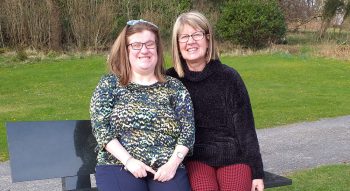01/05/2020

Our Podiatry Service thank Bronagh Devlin and her mum Mary for sharing their patient story on the positive impact that Alan McCaugh, Specialist Podiatrist for Learning Disabilities has had on their lives!
Bronagh is a young woman with adult learning disabilities living in the Western Trust area. Her mother, Mary is her primary carer.
Bronagh was referred to podiatry because she walked on the outsides of her feet, in a slow and awkward manner.
Her ability to walk short distances and to manage steps had deteriorated. Her mother described this as walking in a “clumpy manner, not bending her feet, and wanting to link on to my arm at all times.”
Her mother added “It felt like I was dragging her along. She tired easily and her ankles could swell.”
Bronagh was diagnosed with dyspraxia and severe learning disability as a child. She had poor balance and co-ordination.
“She never had been agile and her motor skills were delayed or under-developed” her mother explained. “Bronagh had ongoing difficulties with her walking for years but I could see a progressive deterioration. This concerned me in relation to her being able to maintain her mobility.
“The worse her walking got, the less she wanted to walk and the shorter the distance she’d walk.
“She was becoming more sedentary and her muscles were tightening. It was a vicious circle. She was also gaining weight, which did not help her mobility”.
At this stage the podiatrist steps in.
Alan McCague is a senior podiatrist in the Western Trust who has specialised in learning disability for decades. He has a deep appreciation and knowledge of the specific difficulties and challenges of people with adult learning disabilities. His knowledge, skills and expertise in this area of podiatry are extensive (he has also been a volunteer podiatrist with the Special Olympics globally for 18 years).
Bronagh was 34 years old when referred to Alan McCague.
“Mr McCague assessed her and we discovered that one of her legs was shorter than the other by one and half inches. We never knew this before,” continued Bronagh’s mother.
“She needed moulded insoles in her shoes to correct the shortness of one leg and also to correct the position of her feet inside her shoes – to correct her walking on the outside of her feet.
“She needed to exercise and stretch the tendons and muscles in the back of her lower leg and ankle area to encourage her to bend her feet when walking.
“She was given specific exercises to do, these stretched her feet and toe joints,” Bronagh’s mother said.
The podiatrist examined some large moles on Bronagh’s feet. They were measured, and she was sent to a specialist for assessment.
“We were given information and advice regarding her shoe wear, nail and foot care. Then she received the insoles from the Medical Appliance Centre in Altnagelvin Hospital”.
Immediately both Bronagh and her mother noticed a dramatic difference. The results were apparent from the outset.
Bronagh’s mother continued “Straightaway her posture, gait and speed of walking improved. She was not walking on the outsides of her feet, and she was not ‘clumping’ down our stairs. She still wanted to arm link on me when outside, but she was no longer leaning heavily on me or lagging behind.
“She can walk longer distances, and we are doing the stretches which is helping her feet and toes bend more naturally.
“I am no longer worried about her future mobility.”




